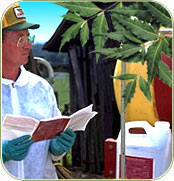Neem Residual Toxicity

Residual Toxicity is the toxins that are left as a residue after pesticide application. Residual toxicity has hazardous effect on the end product. Residual toxicity affects the whole chain. It affects the organism at every trophic level. Like, cholrinated water taken by a fish makes it poisonous and when the fish is consumed by an Albatross it becomes contaminated and then when it is consumed by man it proves to be hazardous. Thus it is very clear that residual toxicity has a capacity to affect the Food Chain.
OT is one such pesticide which is known for it's non residual effect on crops. It is totally biodegradable. Thus it results in non-poisonous products of those crops on which it is applied, like-
- Poison Free Coconut
- Poison Free Tea
- Poison Free Cotton
- Poison Free Paddy
Please follows the following instruction carefully and very strictly to get the maximum benefits of Neem Insecticides :-
- First check the ph of water to be used for spraying, if it is neutral i.e. 7 or alkaline i.e. more than 7, then add some lemon juice or citric acid or acetic acid (vinegar) to make it below 7 ph (It is very very important because Azadirachtin is unstable at high ph) and in alkaline water.
- First pour the neem insecticide in the sprayer and then add water into it (never add water first while spraying neem insecticide), because density of neem insecticide is lower than water and insecticide may not properly emulsify if added of afterwards which may result in scorching and lower results.
- Spray during evening time preferably during sun set (This is because Azadirachtin is highly suspectible to heat and light in the initial stages of absorption).
- Spray continuously 3 times at a regular interwal of 6 days for short term and long term results (visual results) and then after an internal of 10 days depending on pest infestation.
- Most important, after using our neem insecticide Insect/Pest will stop harming the crop immediately within minutes of spray (our aim is to protect crop) and insect will start getting enlarge (very contradictory it seems) DUE TO SWELLING (insect throat will be blocked and he will start vomiting and die of hunger), insect will start getting die after 24 hour and conditions 3 spray will give you optimum results compare to any insecticide in the world (that's guarantee).
- There is no chance to develop resistance against our Neem Insecticides (as it happens mostly in the cases of Chemical Insecticides) as it contains more than 60 compounds that are highly effective and complementary to each other.
- Different Synthetic/Chemical insecticides are used for different insects but our neem insecticides are so wonderful and broad spectrum that it alone covers more than 600 species of Insects/Pests. Its true more over predators are absolutely safe with Neem Insecticides and contrary to chemical insecticides it's dosages will decrease over time when used regularly (that sure). Your expenses and problem will start diminishing only after using neem
insecticides chemical pesticides dosage has to increased day by day due to resistance on pest and killing effect on predators.
- Mix 2.5 mi. of this product per litre of water.
- All the doses mentioned are for high volume sprayers, where normal spray volume is 1000 L&a. Spray volume however can be changed as per efficiency of sprayers used.
- After fruit set, all fungicides containing Mancozeb or
Dithiocarbamates and Sulphur should be avoided.
- Dinocap should not be used when tender shoots are present incanopy.
- Recommended PHI will be valid only if maximum 2 sprays are applied per fruiting season at 7-15 days interval at recommended doses.
Neem Remedy
- Neem Remedy
- Dark Circle Home Remedies
- Boils Home Remedies
- Hair Fall Home Remedies
- Arthritis Home Remedies
- Chicken Pox Home Remedies
- Scabies Home Remedy
- Eczema Home Remedies
- Neem Cancer Treatment
- Neem and Diabetes
- Neem Dandruff Remedies
- Neem and Hypertension
- Neem and Heart Disease
- Neem and Digestive Problems
- Neem and Skin Disorders
- Neem and Sexual Disorders
- Neem and Periodontal Problems
- Psoriasis Treatment
- Neem for Dry Skin
- Neem and Ayurveda Applications
- Neem Knowledge Centre
- Medicinal Properties of Neem Tree
- Neem Side Effects
- Biological Control
- Crop / Pest Management
- Neem a Universal Remedy
- Neem Extract Products
- Agriculture Uses of Neem
Trend in Cosmetic Industry
Last few decades have witnessed a great demand for herbal cosmetic products, away from synthetics, this so, because these herbal and natural cosmetics...Know More
Trend in Pharmaceutical Industry
The traditional and the modern medical systems have always co-existed in a large number of countries aroundthe world. While India has the existence of Ayurvedic...Know More
Trend in Health Care Industry
With the rise in healthcare costs, after effects of pharmaceuticals and synthetic products, natural and herbal products are in great demand all over...Know More
Trend in Traditional Medicine Industry
Neem has essentially been used for centuries now, in different traditional medicine systems like Ayurveda and Unani system. It is used to manufacture...Know More
